Affiliate disclosure: This post may contain affiliate links. Please see our Privacy Policy.
A Herbal Oxymel is a really lovely way to take your medicine and get a boost of probiotics at the same time.
An oxymel is basically just herbal material infused with raw vinegar and honey, making a tangy syrup that’s soothing for sore throats, coughs, colds, and all manner of minor illnesses (depending on the herbs used).
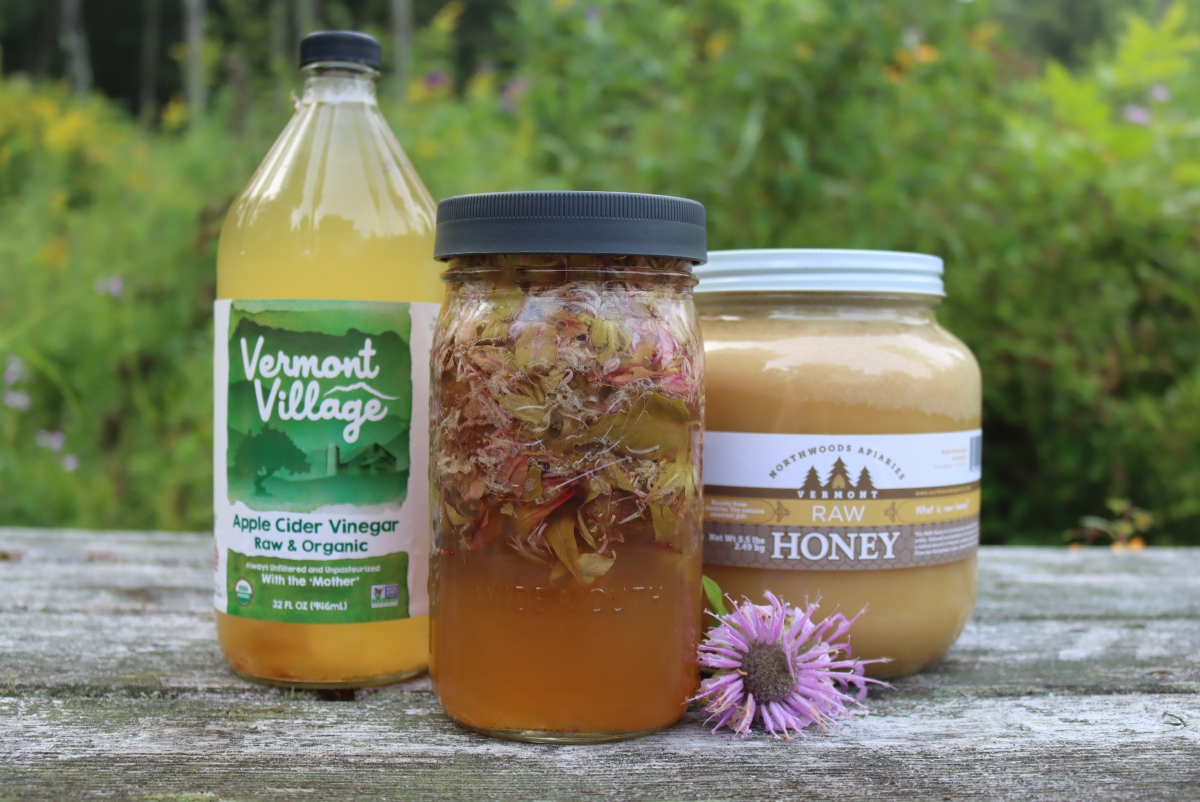
Most people are familiar with herbal teas, but they’re just one of many ways to take your herbal medicine.
Once you’ve got a bit more experience with herbs, you might learn about herbal tinctures, herbal infused oils, and herbal salves as well. Herbal syrups are pretty well known too, the best example being elderberry syrup.
Oxymels are just another form of herbal preparation, and they’ve been used for millennia (since Roman times at least).
They’re easy to make at home with just a few simple ingredients.
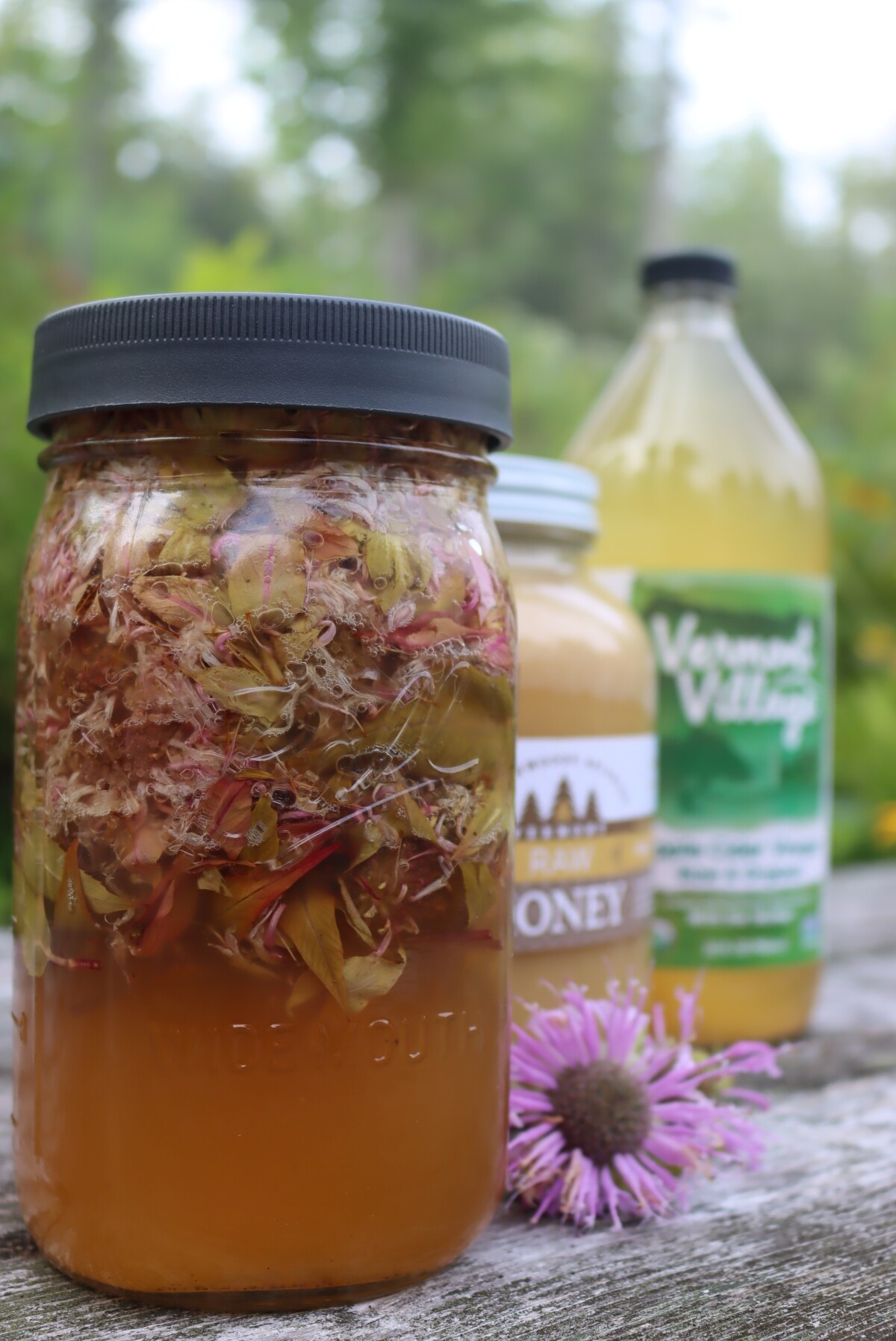
(Always consult your doctor or a clinical herbalist before trying any new herbal remedy, as there’s always the possibility of unintended consequences, allergic reaction, or interactions with other medication. If you’re harvesting wild plant material, make sure you’re 100% confident in your identification and consult multiple sources for your ID. The following is based on my research and experience, but I don’t claim to have any certifications that would qualify me to advise you on your health. Please do your own research and always verify with multiple reputable sources.)
What is a Herbal Oxymel?
A herbal oxymel is a mixture of herbal material, honey, and raw vinegar.
The most famous oxymel is Fire Cider, which combines immune-stimulating and antimicrobial herbs with honey and vinegar to make a general tonic.
Many different herbs can be made into an oxymel, depending on your goals. Some are good immune stimulants, others are used for sore throats and cough remedies.
The main thing is that the herbs are infused into both raw vinegar and honey.
The raw vinegar, usually apple cider vinegar with the mother, helps to preserve the herbs, extracts their medicinal properties, and in some cases makes them more bio-available through fermentation.
Honey sweetens the mixture, making it more like a syrup, but it also extracts medicinal compounds from the herbs. As a bonus, honey is also anti-microbial and raw local honey helps combat seasonal allergies as well.
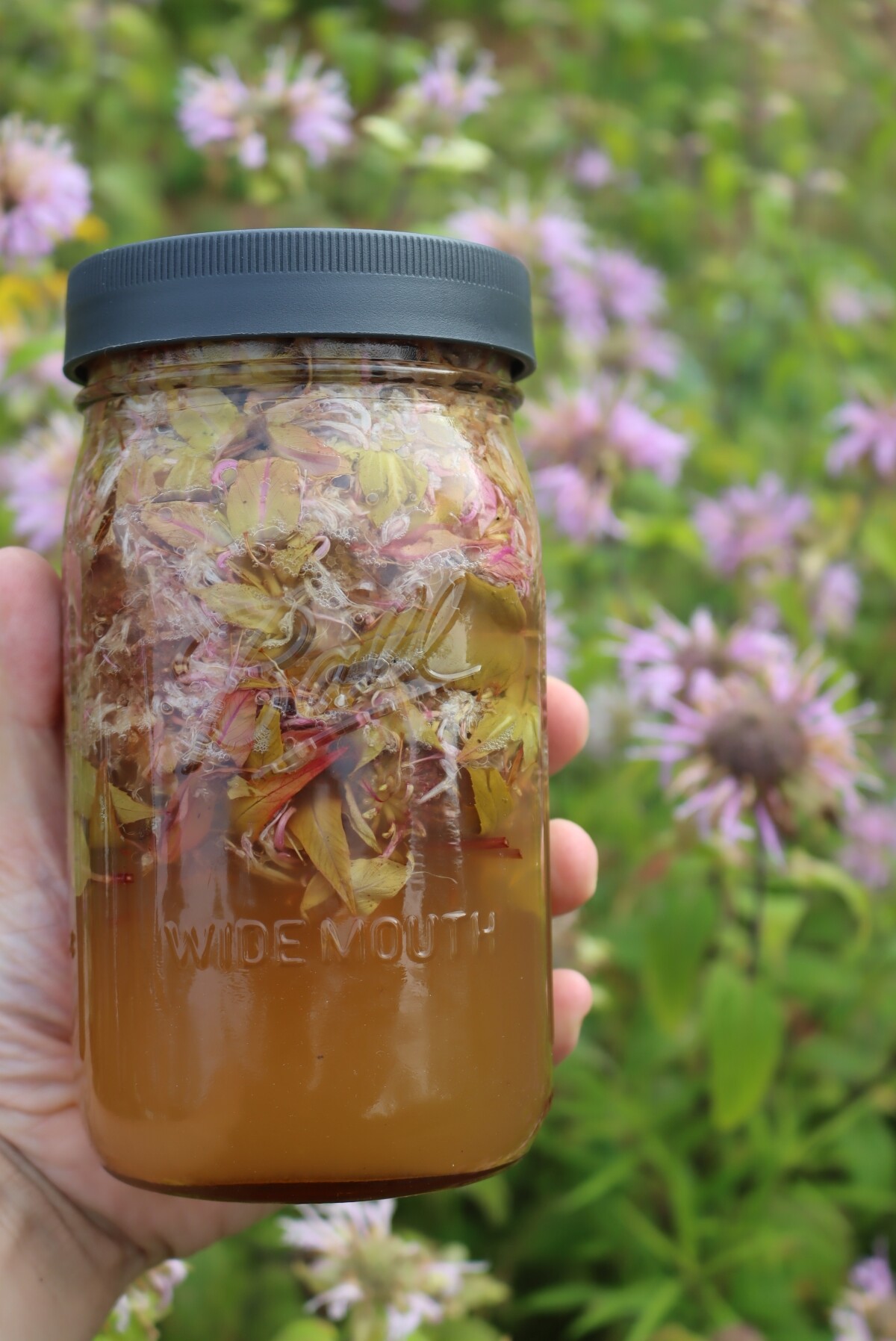
How to Make a Herbal Oxymel
Making a herbal oxymel is pretty simple.
The most basic method is as follows:
Start by filling a jar about 1/4 of the way with dried herbs, or 1/2 to 3/4 full with fresh herbs. This is a rough measurement, as dried herbs tend to pack tighter than fluffy fresh herbs.
Roots and berries are quite dense, and you’ll want to use less of those. For elecampane root, echinacea root, and elderberries I’ll only fill the jar 1/4 full.
Fresh flowers tend to pack quite loosely, and I’ll fill a jar completely full when making bee balm oxymel with fresh blossoms.
Use your best judgment here.
You still need plenty of space for honey and vinegar, so don’t pack the jar tightly in any case, and avoid overdoing it with pungent herbs like horseradish and ginger.
Honey to vinegar ratios vary considerably, and that’s more a matter of personal taste. Historically, oxymels were almost entirely honey infusions, with just a bit of vinegar added.
In Roman times, the rough ratio was 5 parts honey to 1 part vinegar.
These days, most herbalists opt for a more equal ratio. They use either 2 parts honey to 1 part vinegar or an even ratio as I do.
You can even make a tart version with the ratio reversed, using mostly vinegar and just a bit of honey. It’s up to you.
For a 1:1 ratio of honey and vinegar:
Pour in vinegar until the liquid comes about halfway up the jar. Next, pour in honey to fill.
Put on a good solid leakproof lid, and shake thoroughly until everything’s evenly distributed.
If you’re using a mason jar, the vinegar tends to rust the standard metal lids and it’ll make a mess of everything. There’s a gross metallic taste that leaches into the mix, not to mention that the jar can rust shut.
Instead, I use these BPA-free plastic leakproof mason jar lids and they work wonderfully.
Screw the lid on tight and give the jar a good shake. The honey and vinegar should be well mixed and the herbs evenly coated.
Allow the mixture to infuse for 2 to 6 weeks, then strain out the herbal material.
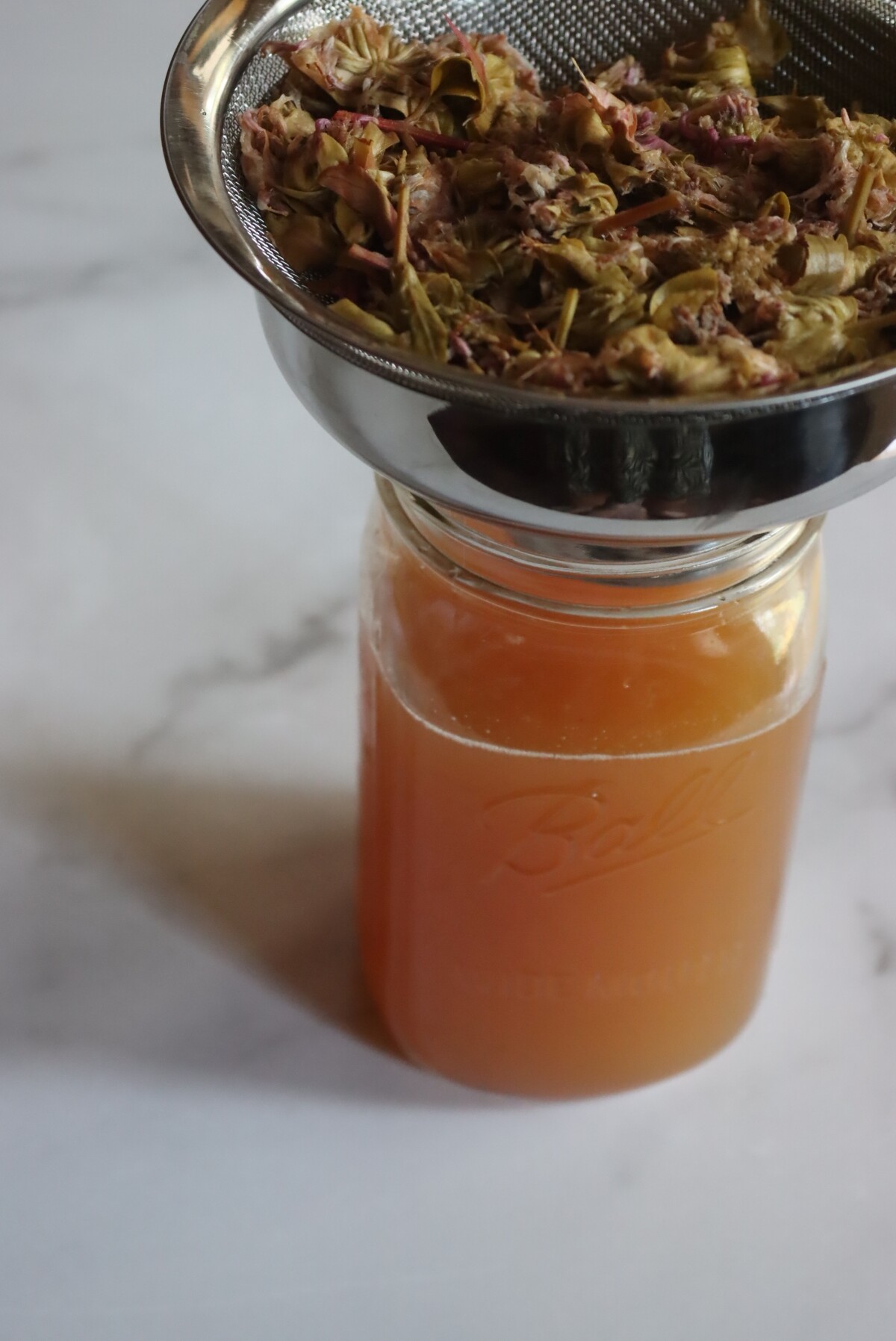
Mountain rose herbs suggest that oxymels will last about 6 months if kept in a cool dark place. Other herbalists suggest keeping oxymels in the refrigerator and using them within 2-3 months, while others say they’re good for years.
The shelf life is less about spoilage and more about how long the oxymel will retain potency. A mixture of vinegar and honey will only ferment to more vinegar, provided you’ve completely strained the herbal material there’s really nothing to spoil.
They’re most potent within 6 months, but I store them for a full year at cool room temperature (pantry, root cellar, etc) until I’m able to make another batch the following year. I haven’t noticed any drop in potency, at least personally.
(The herbal academy has a really detailed guide to the shelf life of herbal preparations, and they suggest a shelf life of 1 year at room temperature for oxymel made with dried herbs. When made with fresh herbs, however, they recommend refrigerating the mixture and give a shelf life of 6 months.)
Alternate Oxymel Methods
Beyond just infusing herbs into a mixture of honey and vinegar, some people choose to infuse herbs separately. They’ll infuse one jar of honey with herbal material and another with vinegar.
They mix them after the infusion is complete, once the herbal material is strained out.
This has its benefits, namely that you can also use the infusions separately. If you want just herbal-infused honey for sweetening your tea, you have it. You can mix them together to make oxymel as needed, but otherwise, keep them separate as you wish.
The downside here is that herbal-infused honey is really incredibly difficult to strain since it’s so thick.
This separate method only works with dried herbs, since infusing fresh herbs into honey will quickly result in alcoholic fermentation and can occasionally result in spoilage or mold in the wrong conditions.
Personally, if I’m making an oxymel I just mix all 3 ingredients and go to it. If I want herbal infused honey, like the dried elderberry infused honey shown below, I make that separately. The same goes for herbal-infused vinegar.
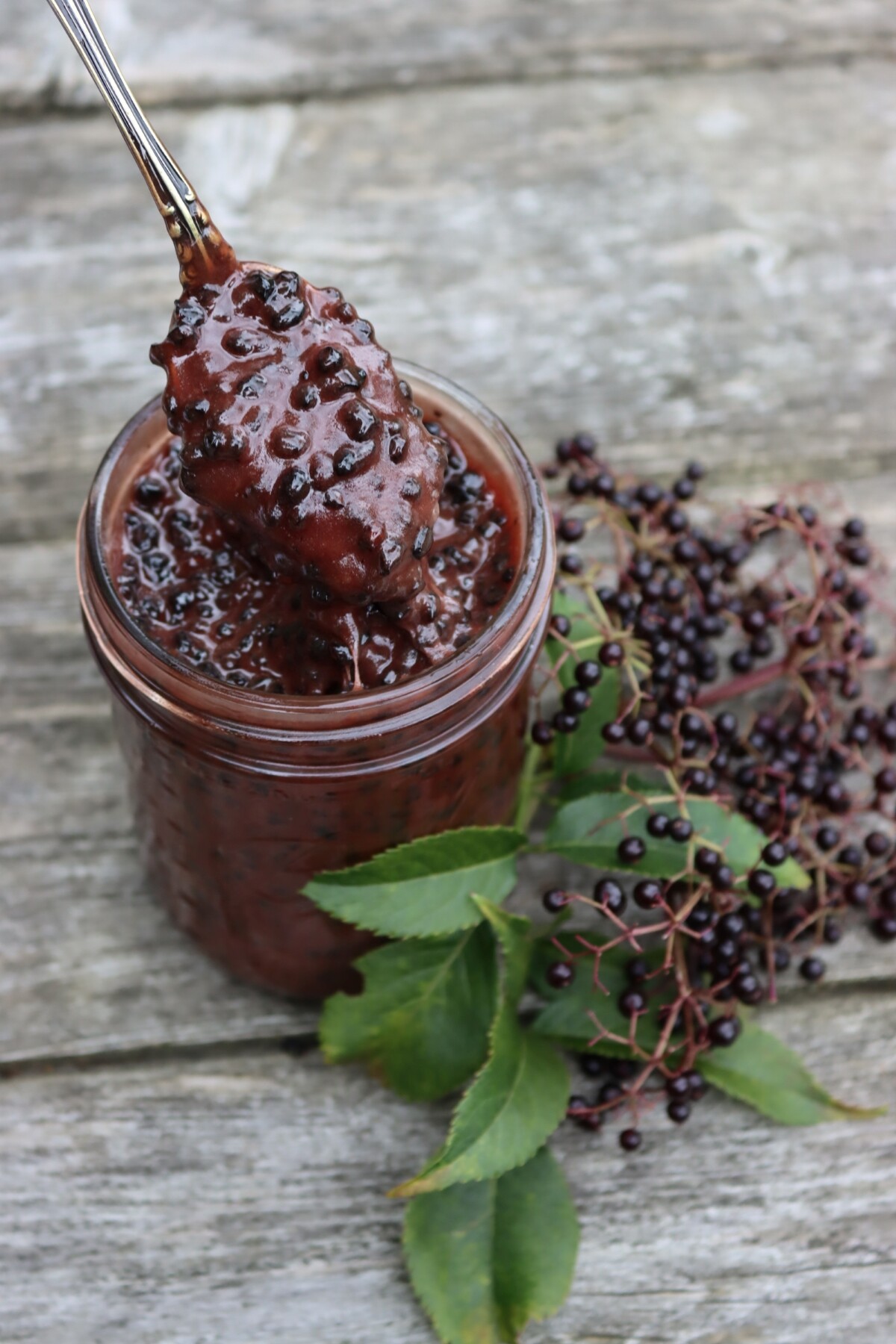
Oxymel Contraindications
Oxymels are generally considered a mild, gentle, and safe herbal preparation. Of course, that assumes that the herbs used are appropriate for the individual and that they have no adverse reactions to those preparations in general.
That said, there are a few contra-indications that are specific to oxymels.
Never give honey to young children under 1 year of age. These days, some doctors are now saying better hold off until at least 2 years of age. Since this remedy includes honey, it’s not appropriate for young children.
The actions of some herbs are changed by fermentation, many for the better. Turmeric, for example, becomes a much more potent anti-inflammatory when prepared as fermented turmeric.
Other herbs, however, change negatively when fermented and they’re not appropriate for oxymels.
Good examples include wild cherry bark and melilot. Both of those herbs become toxic after fermentation.
If you’re interested in fermenting with herbs, I’d suggest this course on herbal fermentation as a resource.
When getting started with oxymels, or herbal remedies in any form, it’s important to know as much as possible about the herbs you’re working with to prevent any such issues.
In the beginning, I’d suggest following established recipes from trusted sources, or working with herbs you know well in preparations recommended by a clinical herbalist, doctor, or naturopath.
Common Types of Herbal Oxymel
I’ve included a number of common types of homemade herbal oxymel below, and they’re a great place to start with this herbal preparation.
If you decide you’d like to begin formulating your own oxymel recipes, I’d suggest doing a bit more research if you’re a beginning herbalist. The Herbal Academy’s course on Herbal Formulation is a great place to start since it covers homemade herbal formulations and combining herbs for maximum benefit.
For an even more basic overview, they also have a Herbal Preparations 101 course that covers making all manner of herbal remedies at home, including salves, tinctures, and more.
Garlic and Thyme Oxymel ~ Thyme is a powerful anti-congestant that’s used for respiratory support, such as during colds and flu. It combines well with garlic which is added to immune system support and for its anti-inflammatory and anti-microbial properties.
Elderberry Oxymel ~ Elderberry is well known for its support of the immune system, and studies show that it can help shorten the duration of cold/flu. I make elderberry tinctures as well, but oxymel is alcohol-free and is absolutely delicious.
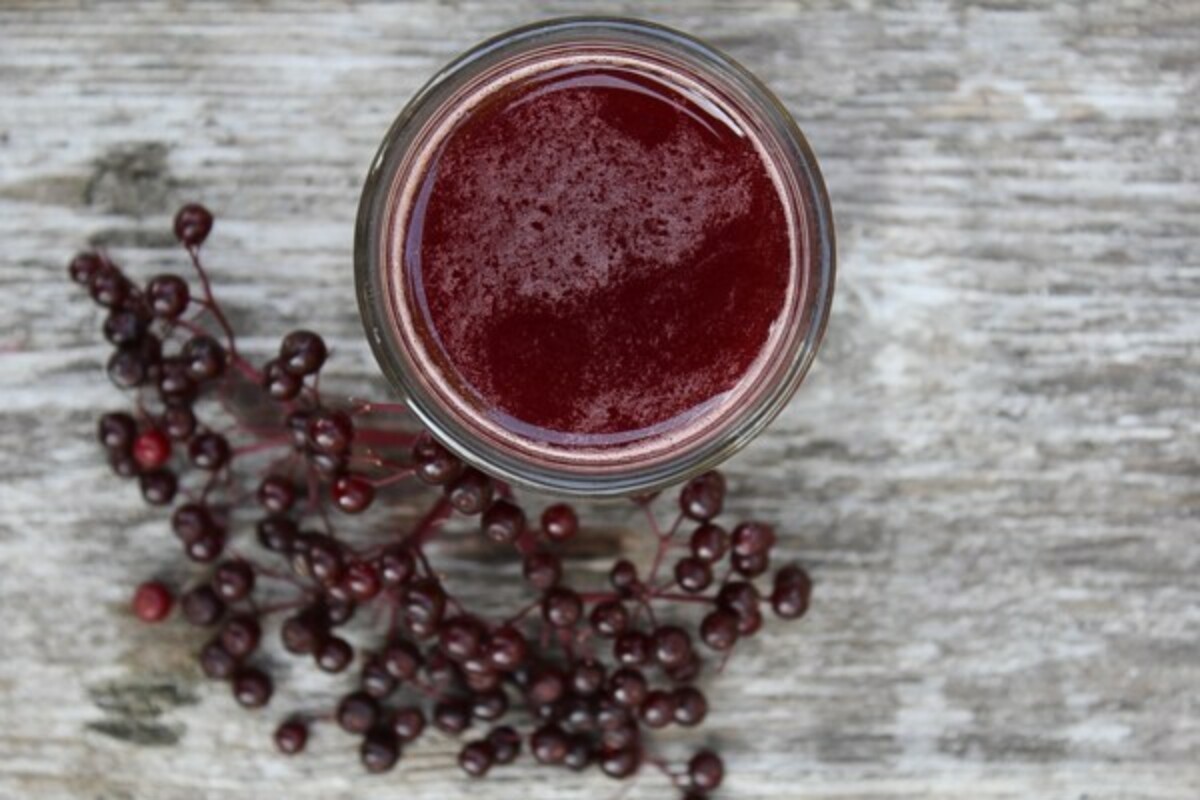
Horehound Oxymel ~ Though it’s not a well-known herb these days, horehound used to be widely used in old-fashioned horehound candies. It’s used for digestive support, bloating and indigestion. Horehound is also used for coughs, colds, and flu. Oxymel is a good choice for both of these uses.
Sage and Ginger Oxymel ~ Ginger acts as a warming immune stimulant, while sage is beneficial for sore throats and cough. Taken together they taste wonderful and work well together.
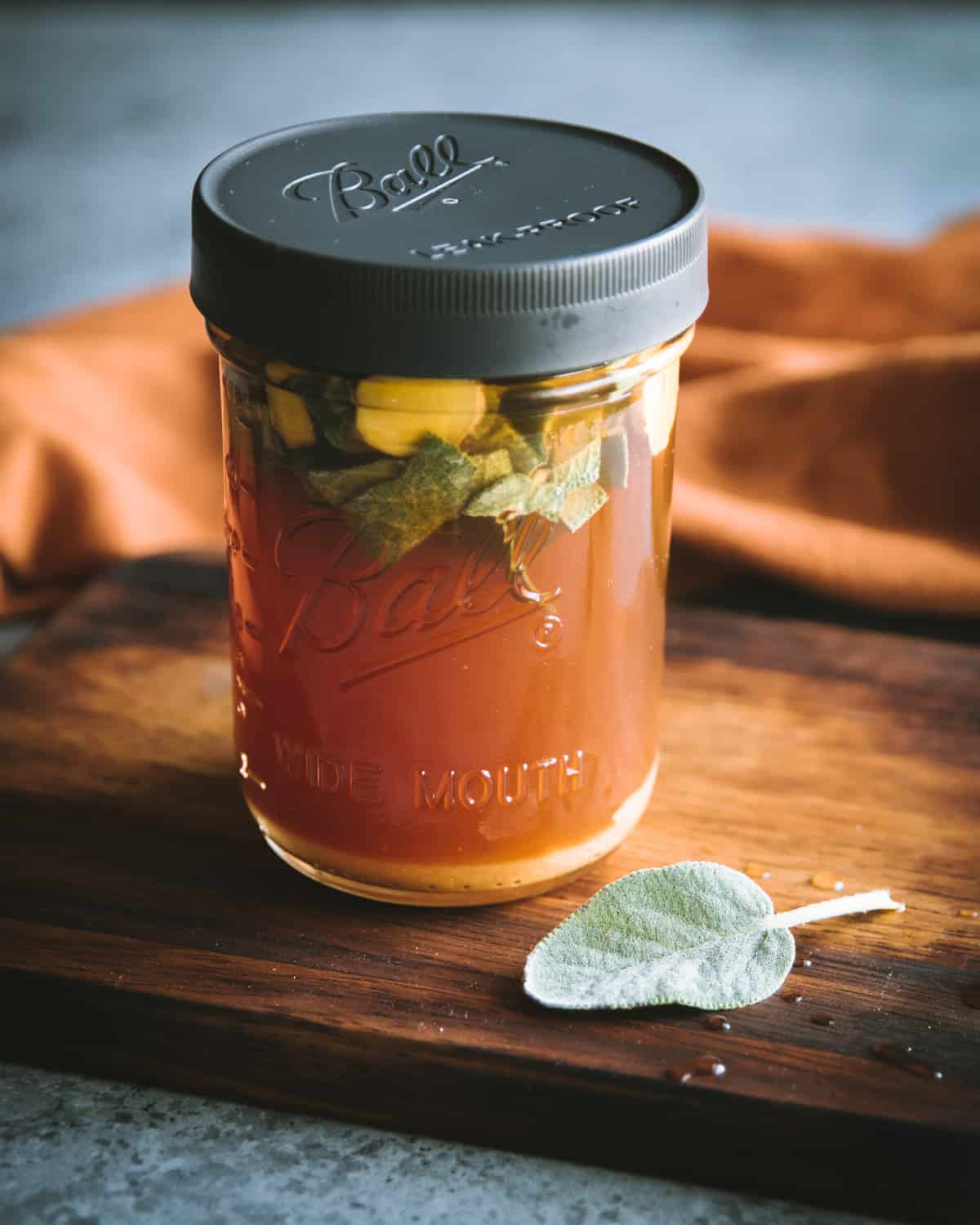
Dandelion Root Oxymel ~ Dandelion root is used medicinally as a digestive bitter, diuretic, and general tonic that supports the elimination of wastes from the skin, liver, kidneys, and lymphatic system. A dandelion root tincture is commonly used for these purposes, but a dandelion oxymel is also an appropriate herbal preparation.
Bee Balm Oxymel ~ It’s incredible how many uses there are for bee balm, a beautiful mid-summer flower. As an oxymel, it’s used to soothe sore throats, and it’s not only warming and comforting but also anti-microbial.
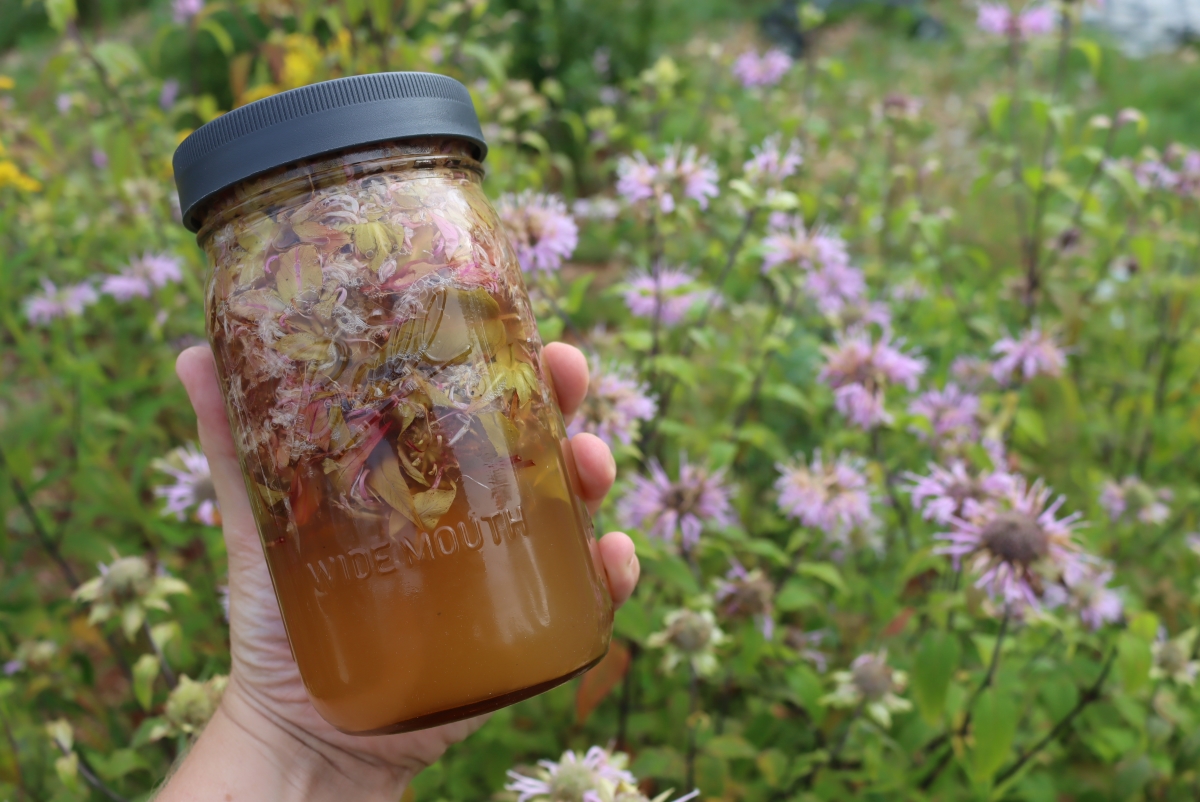
Beyond these basic herbal oxymel recipes, there are a number of other herbs that work particularly well in this traditional preparation.
Mountain Rose Herbs suggests making oxymels with any of the following:
- Lemon Balm
- Hyssop
- Nettle
- Tulsi (holy basil)
- Rose Hips
- Turmeric
- Basil
- Elecampane
- Mullein
- Thyme
- Oregano
- Rosemary
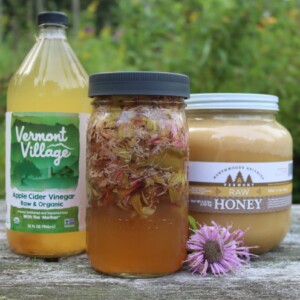
How to Make a Herbal Oxymel
Ingredients
- Herbs dried or fresh
- Honey preferably local, raw honey
- Apple Cider Vinegar with the Mother
Instructions
- Fill a jar about 1/4 of the way full with dried herbal material, or 1/2 to 3/4 full with fresh herbal material.
- Pour apple cider vinegar over the herb until the liquid line is at the halfway mark.
- Fill the jar near the top with honey.
- Cap the jar and shake vigorously to mix ingredients.
- Allow the contents to infuse for 2 to 6 weeks.
- Strain the herbal material.
- Store in a cool dark place for up to a year (with dried herbs) or store in the refrigerator for up to 6 months (if made with fresh herbs).
Notes
- Garlic
- Echinacea
- Elderberry
- Bee Balm
- Lemon Balm
- Hyssop
- Nettle
- Tulsi (holy basil)
- Rose Hips
- Turmeric
- Basil
- Elecampane
- Mullein
- Thyme
- Oregano
- Rosemary
- Sage
Disclaimer on Homemade Herbal Remedies
I’ve been foraging wild medicines and treating my family with herbal remedies for the past 20 years, but I’m self-taught. Be aware that I am not a clinical herbalist, and this is based on my own research and personal experience using medicinal plants. I do not claim to have the experience that’d qualify me to advise you on your health, and I’m only providing this as a reference to encourage a broader interest in medicinal plants.
Please use this as a jumping-off point, but always do your own research and verify anything you read with multiple sources.
It’s always possible to have an adverse reaction to any medicinal herb, and plenty of people are allergic to even gentle herbs like chamomile. Always consult your doctor or a certified herbalist before trying any new medicinal plant. Often, they can have unintended reactions in combination with other herbs and supplements, and many herbs have side effects even when they are effective for their intended purpose.
If you are seriously interested in herbal medicine, I’d suggest investing in a course in herbal medicine, and I’d recommend any of the online courses put out by the Herbal Academy of New England. Specifically, the introduction to herbal medicine course and the family herbalist group of courses.
They also have a mushroom course, covering both medicinal and edible mushrooms, and a Botany and Wildcrafting Course. I’ve taken both and they’re informative, inspiring, and artfully presented.
Herbal Preparations
Looking for more information on common herbal preparations you can make at home?
Homemade Herbal Remedies
Many herbal remedies are easy to make at home. Try any of these simple recipes:
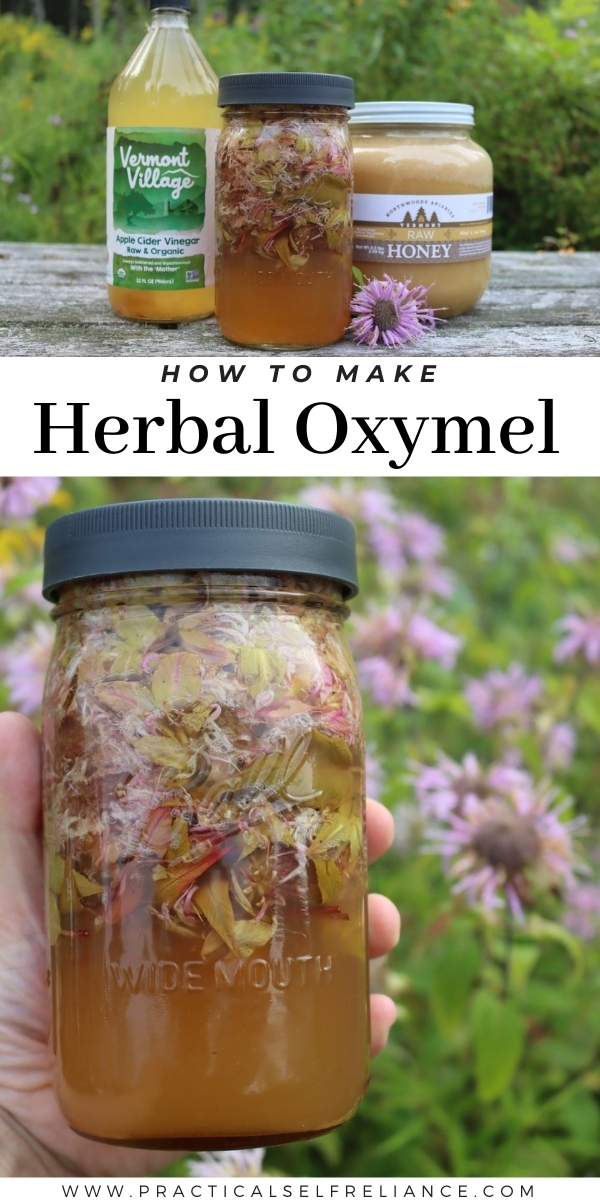


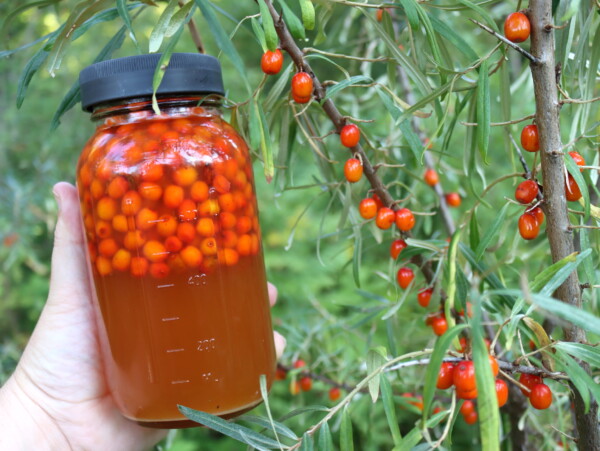
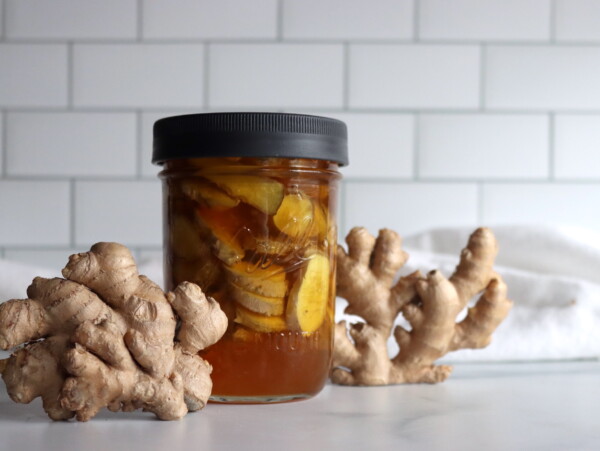










Holy Cow – I was all set to make an oxymel with wild cherry bark as an ingredient! There are a lot of recipes out there with it as an ingredient. Thank you SO MUCH for the warning. I have relied on your smarts many times!
In a few days I’ll decant my blueberry and blueberry leaf oxymel and I plan to make more!
Lovely!
Hello, is it possible to make an oxymel with aronia berry juice? Or is there another safe way to preserve/can it for use in the winter? Thank you so much for your time. I truly appreciate your time and the information you share.
You can either freeze or can fruit juice to preserve for the winter.
Once you have your oxymel ready, and it’s in the dropper bottle, how many drops do you recommend a day, is it different for each herb? The one I plan to use is for rosemary, for memory and brain health! I’m having a hard time finding dosages and whatnot! Thanks you
An oxymel is typically used more in a culinary way although it does have some herbal benefits which is probably why you don’t see a lot of specific dosage amounts. I would just use it to taste in the beverage of choice, you can include it in a vinaigrette or even use it as a topping as you would any other kind of syrup.
lovely lesson for a cold winters day to stay busy, thank you